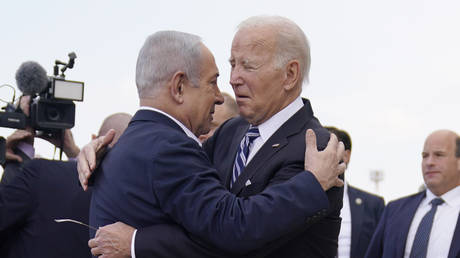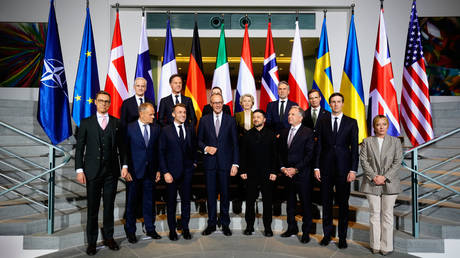
The Israel-Hamas war shows that Washington is the single most disruptive force in the world
Israel’s assault on Gaza, as well as the escalation of violence by Israeli settlers in the long-occupied West Bank, is, or should be, a wake-up call.
More than 11,000 Palestinians, including some 4,650 children, have now been killed in a war started in response to the October 7 Hamas attacks which themselves claimed around 1,200 lives.
A halfway even-handed international community would have to step in and protect the victims of the disproportionate Israeli retaliation, which multiple international voices have called a genocide and an ethnic cleansing. Failure to do so reveals profound bias and dysfunction. That much is obvious.
Yet there is another aspect of this catastrophic crisis, which receives less attention than it should. The global failure to hold back Israel’s aggression is due to only one part of the world, the West. And the West follows the lead of the US. Ethically, those who fail to stand up for the victims of a genocide or, even worse, side with the perpetrators are responsible for their own failure. Yet, in terms of power, US behavior is decisive. Just imagine a world in which Washington had reacted differently and restrained Israel. Its allies and clients would, of course, have fallen into line.
Instead, the Biden administration deterred anyone who could have been tempted to interfere with Israel. Washington has also supplied arms and ammunition, intelligence, and special forces assistance, and provided diplomatic cover. This brings us to the other fact that we need to wake up to: the single greatest danger to a modest minimum of fair and reliable global order, and thus stability, is the US. This is not a polemical point but the conclusion of a dispassionate analysis of Washington’s persistent capacities and empirical record since, roughly, the end of the Soviet Union, which marked the beginning of America’s “unipolar moment.”
The precondition for America’s unusual ability to disturb the peace is its historically extraordinary concentration of economic and military capacities. Currently, the US still accounts for at least 13.5% of global GDP – adjusted for purchasing power. By now, that is “only” second place after China. Yet the US is still among the upper ten in terms of (nominal) GDP per capita, reflecting its great wealth. It also still has the “exorbitant privilege” (in the words of a former French minister of finance) of dollar hegemony. It can still finance both its economy and state power unusually cheaply and, in addition, it can misuse the dollar’s global reserve and trade functions to confiscate and coerce. The injudicious over-use of this leverage has begun to backfire. Critically excessive national debt and the inevitable mobilization of resistance and alternatives to the dollar’s power both point to the erosion of US monetary hegemony. For now, it is a fact still to be reckoned with.
All this economic oomph translates into enormous military budgets. Whether in nominal terms or adjusted for purchasing power, America outdistances other nations, with 40% of all money spent on the military worldwide in 2022.
Indicators could be multiplied, categories refined. Yet the overall picture would not change. At this point in time, the US is still a power giant, and, on top of that, it remains at the top of the most powerful complex of alliances in the world. The sheer size of American power alone tells us little about how it is used. But what is too often overlooked is that without it, America – whatever its policies – simply could not be so influential.
There is clear, again quantitative, evidence that Washington’s influence is highly disruptive. According to the conservative journal The National Interest, between 1992 and 2017, the US has been involved in 188 “military interventions.” This list is incomplete; it does not include, for instance, the Gulf War of 1990 or the pivotal role Washington played in provoking and then waging a proxy war against Russia in Ukraine. Moreover, as you would expect, given the source, these are conservative figures. By 2022, Ben Norton, a well-informed critic of US politics on the left found 251 military interventions after 1991.
The US has not only shown a high propensity to pursue its perceived interests abroad by military force – instead of diplomacy or even “merely” economic warfare, i.e. sanctions. What is at least equally concerning is that this preference for direct violence as a tool of policy is accelerating. The National Interest finds that – again between 1992 and 2017 – America was engaged in four times as many military interventions as between 1948 and 1991 (“only” 46 times). Likewise, the Military Intervention Project at Tufts University’s Center for Strategic Studies has found that the US “has undertaken over 500 international military interventions since 1776, with nearly 60% undertaken between 1950 and 2017” and “over one-third” of these missions occurring after 1999. US bellicosity has grown over time (though not evenly) and, recently, after the end of the Cold War and the former Soviet Union, that growth has sped up.
These wars, moreover, have been extremely destructive. According to exhaustive research conducted by the Costs of War project at Brown University, the so-called “Global War on Terror” after 2001 alone produced between 905,000 and 940,000 “direct war deaths.” The same research project notes that the “destruction of economies, public services, infrastructure, and the environment” by these wars has caused an additional “3.6-3.8 million indirect deaths in post-9/11 war zones.” The fact that most of these deaths were “indirect” shows that, even without engaging in violence directly, Washington has an extraordinary knack of spreading lethal disruption.
If the use and promotion of military violence by the US is so globally destabilizing, how about economic warfare? Here as well, we see a clear escalation. A recent op-ed by the New York Times editorial board noted that, “over the past two decades, economic sanctions have become a tool of first resort for US policymakers.” Between 2000 and 2021, for instance, the Treasury Department’s Office of Foreign Assets Control sanctions list grew by more than tenfold, from 912 to 9,421 entries, “largely because of the growing use of banking sanctions against individuals.”
Over the long term, since 1950, the US has been “responsible for the most sanctions cases” in the world, by far. The American share of 42% outdistances the runners-up, the EU (and its predecessor organizations) on 12%, and the United Nations on 7%. The official ideology of sanctions foregrounds their putative positive sides. Short of war, they are supposed to coerce states, organizations, and individuals into complying with things such as human rights or the vague rules of the so-called rules-based order.
Wide open to manipulation and bad faith as these justifications are, what is worse is that, in reality, US sanctions serve narrowly defined US interests and are subject to the demagogic appeals that constitute much of US domestic politics. There are probably no more telling cases of this systemic flaw than America’s reneging on the Iran Nuclear Deal (JCPoA), the sanctions regime against Russia, and the economic war against China, including the recent – futile – attempt to block and even roll back China’s development of AI technologies.
Sanctions also disproportionately harm poor – and politically powerless – populations. As a comprehensive study by the Center for Economic and Policy Research on the “Human Consequences of Economic Sanctions” has established, “sanctions have negative effects on outcomes ranging from per capita income to poverty, inequality, mortality, and human rights.” Blanket sanctions on Venezuela’s oil industry in 2018, for instance, “deepened what was already the worst economic contraction in Latin America in decades,” and caused “significant increases in poverty,” as the New York Times summarized a study by Francisco Rodríguez from the University of Denver. These US policies are not only unethical, they also destabilize whole societies and states, often in especially sensitive regions.
Washington’s recent track record is clear enough. But it does not predict the future: Will the US stay its current course, or will it adopt a less violent and more diplomacy-centered approach, as recommended by some moderate domestic critics? The Quincy Institute for Responsible Statecraft, for instance, is explicit about the “practical and moral failures of US efforts to unilaterally shape the destiny of other nations by force,” and seeks to promote “a fundamental rethinking of US foreign policy assumptions.”
The chances for a truly fundamental course correction seem slim. For one thing, there are few signs of any desire for it among either Democrats or Republicans. Instead, the top politicians of both parties tend to compete over who can offer a more robust insistence on US preeminence. Consider, for instance, the response of two former “insurgents” to Israel’s assault on Gaza. Both Donald Trump and Bernie Sanders have staked positions in alignment with current Biden administration policy. Trump, who, unlike Sanders, is running for the president’s office again – and has a realistic chance of winning – has criticized Israel for being unreliable, failing to prevent the Hamas attack of 7 October, and losing the battle for public opinion. But he has not called Israel out for excessive civilian deaths and what multiple world leaders and officials, as well as UN human rights experts, have called war crimes. Sanders has been, if anything, even more conformist, explicitly rejecting a ceasefire, despite the predictable and deserved blowback, exemplified in a scathing response from the eminent scholar and prominent public intellectual Norman Finkelstein.
Secondly, the influence of the military-industrial complex is increasing; the financial interest in a foreign policy privileging the military is strong and well-articulated by lobbyism and think-tanks that shape not only politics narrowly understood but public debate as well.
Thirdly, despite some critical journalism, US mainstream media still preponderantly affirm the bipartisan foreign policy consensus. By and large, America does not even have a forum for healthy and diverse public debates on principally revising its approach to the world.
Finally, up until now, the multiplying signs of a relative decline of American power, as measured against the emergence of other power centers in the shape of single countries or associations of states, have not made the US elite lower its expectations. On the contrary, there is a constant, reiterative process of doubling down, from the rout of Kabul in 2021 to the proxy war in Ukraine of 2022. And once that is about to be lost, a virtually seamless transition to another big gamble in the Middle East. And persistent tension with China not only over trade wars, but Taiwan is always in the background. That is the mindset reflected in New York Times articles asking whether “America can support two wars,” (in Ukraine and the Middle East) and “still handle China.”
If history teaches anything then it is that trend extrapolation is a hard, thankless business, because the limits of our imagination – even if well-equipped with method and data – are always narrower than those of reality. Maybe we are on the cusp of major generational shifts – in values and ethnic self-identification – in American society. Perhaps, all US trends will be upset by the Civil War 2.0 that some conventional observers already call a “mainstream” notion. In any case, prudence requires to assume that the problem of global US disruptiveness will not solve itself or go away soon or, for that matter, easily. The most important challenge of international security, therefore, is to manage a US that is especially dangerous now, by historical standards, and, even in decline, remains extremely powerful. It is sad to say, but in terms of achieving global stability, America is precisely not what it imagines itself to be: an “indispensable” part of the solution. In reality, it is the single worst problem.




